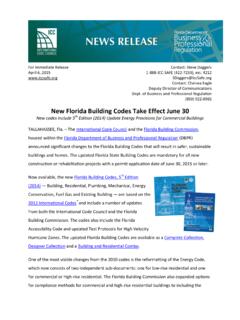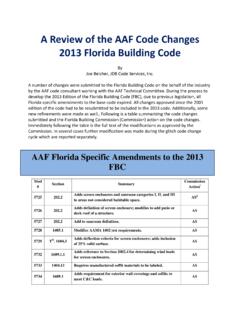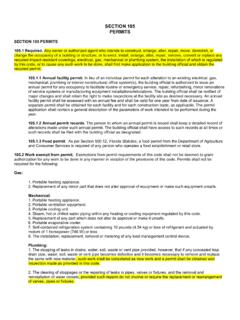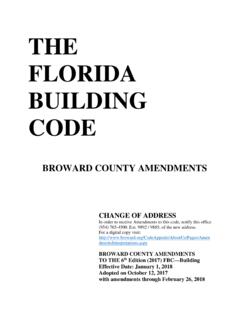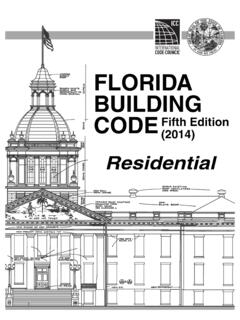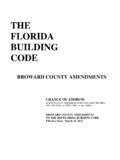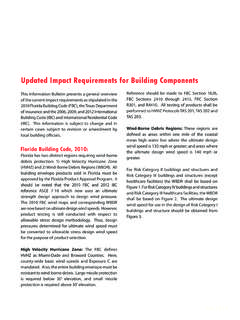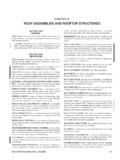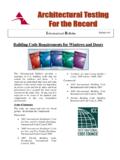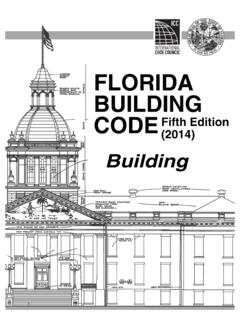Transcription of UNDERSTANDING THE 5 EDITION (2014) FLORIDA …
1 UNDERSTANDING THE 5TH EDITION ( 2014 ) FLORIDA building | N. Venice, FL07/15 MC0100385 2015 PGT Industries, | Product | ServiceSource: ASCE Minimum Design Loads for Buildings and Other StructuresASCE 7 10 WIND ZONE MAP RISK CATEGORY IIWind-borne Debris RegionDesignated areas where the basic wind speed is 140 mph or greater130 mph and within 1 mile of coastNote: This map is accurate to the county, it is not to be used for precise placement of cities near zone 1-37/2/15 4:07 PMPROTECTING THE building ENVELOPE UNDER THE 5TH EDITION ( 2014 ) FLORIDA building CODEThe 5th EDITION ( 2014 ) FLORIDA building code goes into effect June 30, 2015. Previous versions of the FLORIDA building code represented all building types on a single wind speed map. The 5th EDITION ( 2014 ) version separates building types by Risk Categories into three wind speed maps. This brochure will focus on Risk Category II Buildings which include residential for protection of building openings Specified on three different maps based on risk category.
2 Defines and incorporates the High Velocity Hurricane Zone (HVHZ) consisting of Miami-Dade and Broward Counties. Defines areas of the state requiring wind-borne debris protection (see ASCE 7-10 wind map). Areas within 1 mile of the mean high water line (the average between high and low tide) where the wind speed is 130 mph or greater, or any location where the wind speed is 140 mph or greater. Defines wind-borne debris protection. Large-missile impact protection for all openings below 30 feet above grade. Small-missile impact protection for openings from 30 feet above outside HVHZ only: Glazing in Risk Category II building located over 60 feet above ground and over 30 feet above aggregate surface roofs located within 1,500 feet of the building shall be permitted to be unprotected. Includes a system of product for meeting the requirementsOPTION 1: Plywood shutters may be used but they must be a minimum of 7/16-inch thick, precut with a code appropriate anchorage system permanently in place.
3 They may not be used for openings exceeding an 8-foot span or a building mean roof height exceeding 45 feet. They cannot be used where wind w speeds as determined in exceeds 140 2: Approved shutters (must be certified to meet either Miami-Dade TAS 201, 202 and 203 or SSTD12 or ASTM E1886 and E1996 impact tests) may be used except in HVHZ where only products tested to Miami-Dade protocols are permitted. Shutters may be of the roll-down, panel, accordion or other approved design 3: Approved impact-resistant windows and doors (must be certified to meet either Miami-Dade TAS 201, 202 and 203 or SSTD12 or ASTM E1886 and E1996 impact tests) may be used except in HVHZ where only products tested to Miami-Dade protocols are requirements for all windows and doors When window buck (includes standard 1 x pressure treated buck) less than 1-1/2 inch thick is used, window attachment will require fastener penetration through the buck and into the substrate as recommended by the manufacturer.
4 When window buck 1-1/2 inch thick or thicker is used, the buck must be attached in a manner that transfers the load directly to the substrate. Windows must be attached to the buck. The window buck must extend beyond the interior lip of the window, unless otherwise tested. Window and door assemblies shall be anchored in accordance with the published manufacturer s recommendations to achieve the design pressure specified. When window mulling (attaching multiple windows together), mulls shall demonstrate (AAMA 450 using accepted engineering practice or test reports) transfer of the load to the substrate. Generally speaking, this means that mulls will require anchorage to the substrate at each end as well as calculations or test reports substantiating this. The sill height of sliding glass doors may not exceed 3/4 inch above the interior finished floor for residential applications and 1/2 inch for commercial applications.
5 However, for exterior doors serving dwelling units, thresholds at doorways shall not exceed the height required to pass the water resistance test of ANSI / AAMA / WDMA 101 / ,101 / / NAFS or TAS 202 for HVHZ. Flashing at exterior window and door openings shall be installed in accordance with one or more of the following: In accordance with FMA / AAMA 100, FMA / AAMA 200, or FMA / AAMA 250. The flashing manufacturers written installation instructions. In accordance with the flashing method of a registered design professional. The fenestration manufacturer s written installation labeling on windows and doors Exterior windows and glass doors shall be tested and approved by an independent testing laboratory, and shall be labeled with an approved label identifying the manufacturer, performance characteristics and approved product certification agency, testing laboratory, evaluation entity or Miami-Dade Notice of Acceptance to indicate compliance with the requirements of one of the following specifications: ANSI / AAMA/NWWDA 101 TAS 202 (HVHZ shall comply with TAS 202) ANSI / AAMA / WDMA / 101 / / MAFS AAMA/ WDMA / CSA 101 / / A440 Glass strength.
6 Determination of load resistance of glass for specified loads of products not tested and certified in accordance with Section shall be designed to comply with ASTM E 1300 in accordance with Section Impact-resistant products may comply with SSTD 12, ASTM E1886 and ASTM E1996 or Miami-Dade TAS 201, 202 and identification Each pane shall bear the manufacturer s label designating the type and thickness of the glass or glazing material. Exception: For other than tempered glazing materials or laminated materials, the identification shall not be omitted unless approved and an affidavit is furnished by the glazing contractor certifying that each light is glazed in accordance with approved construction documents that comply with the provisions of this chapter. Each pane of safety glazing installed in hazardous locations shall be identified by a label specifying the labeler, whether the manufacturer or installer, and the safety glazing standard with which it complies.
7 The safety glazing label shall be acid etched, sand blasted, ceramic fired or an embossed mark, or shall be of a type that once applied cannot be removed without being destroyed. Exceptions: For other than tempered glass, labels are not required, provided the building official approves the use of a certificate, affidavit or other evidence confirming compliance with this code . Tempered spandrel glass is permitted to be identified by the manufacturer with a removable paper information on construction drawings Ultimate design wind speed Vult (3 second gust) miles per hour (km/hr) and nominal design wind speed Vasd as determined in accordance with Section Risk Category from Table or Table of ASCE 7 Wind exposure Where more than one wind exposure is utilized, the wind exposure and applicable wind direction shall be indicated The applicable enclosure classifications and the internal pressure coefficient (if designing with ASCE 7) Components and cladding The design wind pressures in terms of psf (kN/m2)
8 To be used for the selection of exterior component cladding materials not specifically designed by the registered design professionalWhen using or specifying wind-borne debris protection, you should ask to see one of the following test reports and certification numbers: ASTM E1886 and E1996 FBC Test Protocols TAS 201 and 203 for shutters FBC Test Protocols TAS 201, 202 and 203 for impact-resistant windows Miami-Dade County Product Approval or NOA (Notice of Acceptance) FLORIDA building Commission approval showing compliance with one of the above Local product approval showing compliance with one of the aboveFlorida building code FactsThe first uniform state building code in FLORIDA came into existence in 2002. It was written in 2001 as a result of the FLORIDA Legislation responding to the need for more firm and regulated building codes after hurricane Andrew.
9 Every 3 years, the codes are updated with the most recent version of the International code Council (ICC) as the base code . The FLORIDA building Commission then has the daunting task of adding changes to make them more relevant to our unique environment. Although we do have a uniform state building code , you will discover that each municipality or jurisdiction may have their own special requirements. This happens because the original FLORIDA building code , along with every subsequent version, allows for each municipality or jurisdiction to require greater than those minimum standards, but does not allow for less. As a result, we recommend that the appropriate building department be contacted first to clarify any building code questions and 800-282-6019 How products are approvedStatewide approval of products or revisions to existing statewide product approvals requires evaluation of product compliance with the code by a method listed in Rule , , validation of the evaluation as required by Rule , , and approval per Rule , Validation of compliance with the Codes shall be performed by approved Validation Entities.
10 Final approval shall be issued by the Commission. All products used in construction covered by the code shall comply with the provisions or standards contained therein or with the intent of the code . Approval by the Commission for statewide use shall be limited to the following categories of products: Panel Walls Skylights Exterior Doors Windows Roofing Products Shutters Energy Conservation code Residential Windows and Doors Replacement using the prescriptive path: For renovation that includes replacing windows or doors, the code states that new windows and doors shall meet the requirements of Table Details from Table are shown in the image to the right. There also exists a FLORIDA Statute that defines a renovation as construction that exceeds 30% of the assessed value of property. Per this statute, projects with a scope of work not exceeding this value may not be required to meet the values to the right.
